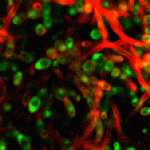Lien vers Pubmed [PMID] – 23508952
J. Biol. Chem. 2013 May;288(19):13387-96
BACKGROUND: SUN proteins are involved in yeast morphogenesis, but their function is unknown.
RESULTS: SUN protein plays a role in the Aspergillus fumigatus morphogenesis. Biochemical properties of recombinant SUN proteins were elucidated.
CONCLUSION: Both Candida albicans and Aspergillus fumigatus sun proteins show a β-(1,3)-glucanase activity.
SIGNIFICANCE: The mode of action of SUN proteins on β-(1,3)-glucan is unique, new, and original. In yeasts, the family of SUN proteins has been involved in cell wall biogenesis. Here, we report the characterization of SUN proteins in a filamentous fungus, Aspergillus fumigatus. The function of the two A. fumigatus SUN genes was investigated by combining reverse genetics and biochemistry. During conidial swelling and mycelial growth, the expression of AfSUN1 was strongly induced, whereas the expression of AfSUN2 was not detectable. Deletion of AfSUN1 negatively affected hyphal growth and conidiation. A closer examination of the morphological defects revealed swollen hyphae, leaky tips, intrahyphal growth, and double cell wall, suggesting that, like in yeast, AfSun1p is associated with cell wall biogenesis. In contrast to AfSUN1, deletion of AfSUN2 either in the parental strain or in the AfSUN1 single mutant strain did not affect colony and hyphal morphology. Biochemical characterization of the recombinant AfSun1p and Candida albicans Sun41p showed that both proteins had a unique hydrolysis pattern: acting on β-(1,3)-oligomers from dimer up to insoluble β-(1,3)-glucan. Referring to the CAZy database, it is clear that fungal SUN proteins represent a new family of glucan hydrolases (GH132) and play an important morphogenetic role in fungal cell wall biogenesis and septation.













